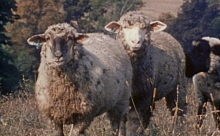Weaver Transcription
- [Narrator] In 17th century America, it was forbidden to kill a sheep until it was two years old. Its wool was crucial to a burgeoning home industry of spinning and weaving. In a massive effort, every family participated in getting the craft moving to provide clothing and cash for the community. Laws were even passed directing each family to train spinners and weavers, regardless of age, status, or sex. The powerful community spirit generated by this work helped pave the way for the American Revolution. Goldenrod, sassafras, poke berries, and Jerusalem artichokes were among dozens of plants used to make dyes.
- [Margaret Carr] The big loom, the big rug loom was brought to this part of the country around 1811, and somewhere through the generations, the loom was kind of lost, and then it was sold to me. It was all apart and it looked just like a pile of lumber. But each piece was numbered, and so we were able to get it together in the proper way. We started in the barn, and then we moved it to the kitchen, and then the dining room, and now it has its own room.
- [Narrator] Margaret Carr is a weaver who creates strong, simple rugs and fabrics. The heavy beating of her loom would've been a familiar sound to the colonial American.
- [Margaret] Basically, all looms are alike, they're you change the thread and you weave another thread in and out. But there are just different actions, and different widths, and different methods to get them opening and closing. I like to create my own material. I like to see the things that I've done. You could take one weave and just do that one weave all your life and never reach the end of it. There's the change of threads and the warmth and color, texture. The number of things that you can do are infinite.
- [Narrator] The fabrics of 18th century America symbolized the heyday of hand weaving. When the craft was both a necessity of life and an art form.
- [Margaret] I think you'll find that the people who are buying hand-woven materials, and rugs, and pillows, and things like to see something different, something that isn't run off a long thing, and they're cut off and they're all just alike. They like to have something that's unique and just their own. They want something that's one of a kind.
- [Narrator] In the early 19th century, the invention of new spinning machinery forced the search for faster methods of weaving. Joseph Jacquard, a former child laborer in a hand loom mill invented a power loom that controlled fabric patterns. This loom marked the first stage in the continuing process of automation. By 1850 men, women, and children were no longer individual workers at a craft, but components of the mill machinery. Wave after wave of immigrant girls and women entered the life of the mills. After working a 59-hour week, their take home pay often amounted to less than $13. Physical exhaustion, the strains of poverty, and mass cultural assimilation did not leave room for the pursuit of an art or for personal dreams. Miserable factory towns and deadening city slums accompanied industrial expansion and the great migrations to the cities. Though they look like a school class let out for playtime, these children were actually laborers taking their lunch break in the midst of a 14-hour day in a spinning and weaving mill. A ready source of cheap labor, children were poured into factories. By 1900, child labor had become a public scandal. One in three quarter million children between the ages of 6 and 15 were employed. Hard work, dangerous machines, and monotonous tasks ruined their health and stultified their minds. The camera's exposing eye pricked public conscience as early as 1890, but it was not until 1949 that child labor was directly prohibited across the nation.
